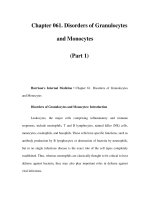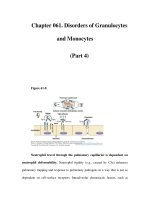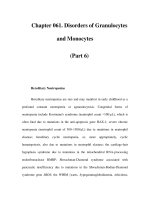Chapter 109. Disorders of Platelets and Vessel Wall (Part 3) pot
Bạn đang xem bản rút gọn của tài liệu. Xem và tải ngay bản đầy đủ của tài liệu tại đây (44.3 KB, 5 trang )
Chapter 109. Disorders of Platelets
and Vessel Wall
(Part 3)
Approach to the Patient: Thrombocytopenia
The history and physical examination, results of the CBC, and review of the
peripheral blood smear are all critical components in the initial evaluation of the
thrombocytopenic patients (Fig. 109-2). The overall health of the patient and
whether he/she is receiving drug treatment will influence the differential
diagnosis. A healthy young adult with thrombocytopenia will have a much more
limited differential diagnosis than an ill hospitalized patient who is receiving
multiple medications. Except in unusual inherited disorders, decreased platelet
production usually results from bone marrow disorders that also affect red blood
cell (RBC) and/or white blood cell (WBC) production. Because myelodysplasia
can present with isolated thrombocytopenia, the bone marrow should be examined
in patients presenting with isolated thrombocytopenia who are older than 60 years.
While inherited thrombocytopenia is rare, any prior platelet counts should be
retrieved and a family history regarding thrombocytopenia obtained. A careful
history of drug ingestion should be obtained, including nonprescription and herbal
remedies, as drugs are the most common cause of thrombocytopenia.
Figure 109-2
Algorithm for evaluating the thrombocytopenic patient.
The physical examination can document an enlarged spleen, evidence of
chronic liver disease, and other underlying disorders. Mild to moderate
splenomegaly may be difficult to appreciate in many individuals due to body
habitus and/or obesity but can be easily assess by abdominal ultrasound. A platelet
count of approximately 5000–10,000 is required to maintain vascular integrity in
the microcirculation. When the platelet count is markedly decreased, petechiae
first appear in areas of increased venous pressure, the ankles and feet in an
ambulatory patient. Petechiae are pinpoint, nonblanching hemorrhages and are
usually a sign of a decreased platelet number and not platelet dysfunction. Wet
purpura, blood blisters that form on the oral mucosa, are thought to denote an
increased risk of life-threatening hemorrhage in the thrombocytopenic patient.
Excessive bruising is seen in disorders of both platelet number and function.
Infection-Induced Thrombocytopenia
Many viral and bacterial infections result in thrombocytopenia and are the
most common noniatrogenic cause of thrombocytopenia. This may or may not be
associated with laboratory evidence of disseminated intravascular coagulation
(DIC), which is most commonly seen in patients with systemic infections with
gram negative bacteria. Infections can affect both platelet production and platelet
survival. In addition, immune mechanisms can be at work, as in infectious
mononucleosis and early HIV infection. Late in HIV infection, pancytopenia and
decreased and dysplastic platelet production is more common. Immune-mediated
thrombocytopenia (ITP2) in children usually follows a viral infection and almost
always resolves spontaneously. This association of infection with ITP is less clear
in adults.
Bone marrow examination is often requested for evaluation of occult
infections. A study evaluating the role of bone marrow examination in fever of
unknown origin in HIV-infected patients found that for 86% of patients, the same
diagnosis was established by less-invasive techniques, notably blood culture. In
some instances, however, the diagnosis can be made earlier; thus, a bone marrow
examination and culture is recommended when the diagnosis is needed urgently or
when other, less-invasive methods have been unsuccessful.
Drug-Induced Thrombocytopenia
Many drugs have been associated with thrombocytopenia. A predictable
decrease in platelet count occurs after treatment with many chemotherapeutic
drugs due to bone marrow suppression (Chap. 81). Other commonly used drugs
that cause isolated thrombocytopenia are listed in Table 109-1, but all drugs
should be suspect in a patient with thrombocytopenia without an apparent cause
and should be stopped, or substituted, if possible. A helpful website, Platelets on
the Internet ( lists drugs reported to have caused
thrombocytopenia and the level of evidence supporting the association. Although
not well studied, herbal and over-the-counter preparations may also result in
thrombocytopenia and should be discontinued in patients who are
thrombocytopenic.









